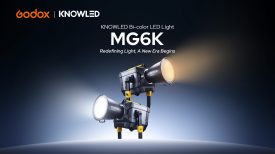SoftPanels LED lights were first shown at NAB in 2016, and funded via a Kickstarter campaign. It’s taken a long time for the production versions of the SoftPanels fixtures to start shipping, and some early backers were left wondering if they would ever receive their lights. Now that they are finally available I thought it was a good idea to look at the lights in more detail.
While a lot of other lighting companies have ventured into making RGBW(W) fixtures, SoftPanels has concentrated on getting the Kelvin colour temperatures we all use right. The SoftPanels LED lights are colour adjustable from 2700K to 7200K which is a nice wide colour spectrum to work with. The fixtures offer a new “Precise Manual Color Mode with verified color temperature accuracy”, a feature that even today’s highest-end professional production LED lights lack. Conventional variable-color LED lighting fixtures often provide a numerical readout of the color temperature that the fixture is supposedly producing. In addition, these traditional LED lights can also provide pre-set buttons to ‘approximate’ a fixed color temperature [e.g., 5500ºK, 3200ºk, etc.]. In either case, these are only estimates, which in some cases can be off by as much as 1000º to 2,000º degrees Kelvin.
These colour errors are only magnified when you mix multiple legacy LED lights on the same scene, as each light may have a substantially different colour temperature. I often hear shooters complain that this light or that light looks green or magenta compared to this other light they are using. This is that exact problem I just mentioned. Lights from different manufacturers don’t often play well together.
To counter this old age problem, SoftPanels enables what they call a “Precision on-set colour workflow”, where you can instantly dial-in one or more SoftPanels to a precise and verified fixed colour temperature, anywhere between 2700K and 7200K using the built-in LED/ambient color metering system. This is claimed to completely avoid the color mismatch issues found with conventional LED lights.
As for the SoftPanels specifications, each unit has full-range 100% ~ 1% dimming, and a claimed 95 CRI using high color fidelity LEDs.
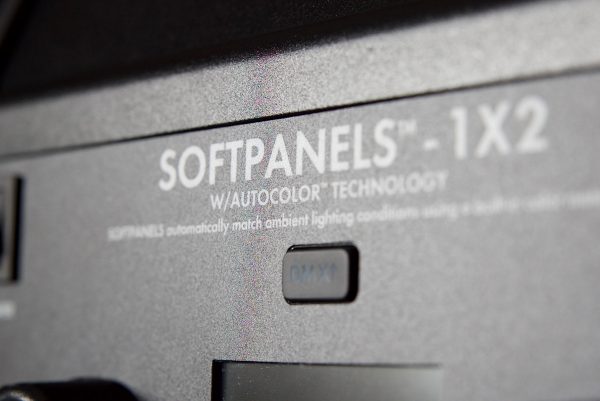
The SoftPanels units come in three sizes – 3×4 ft (90x120cm), 2×3 ft (60x90cm), and 1×2 ft (30x60cm). The 3×4 ft version has a powerful 600 watts of LED output, which is claimed by the company to be the equivalent to the output of a 5,000-watt tungsten soft light. SoftPanels also claim the lights are flicker free and that they run silently. The 2×3 ft and 1×2 ft can both be run on V-lock or Anton-Bauer batteries. All SoftPanels panels come with a honeycomb grid, gel frame, and soft case, and can be mounted either vertically or horizontally.
Autocolor matching technology
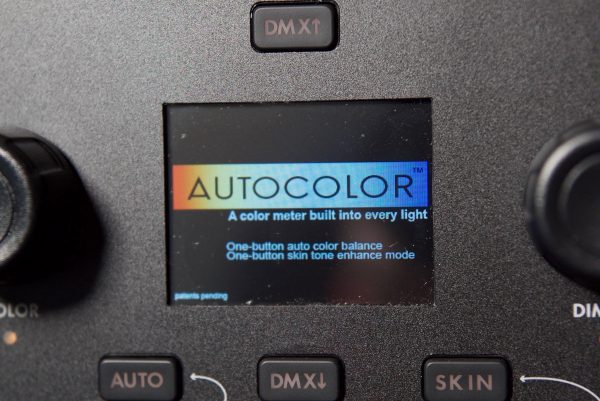
This feature is undoubtedly the SoftPanels biggest selling point. SoftPanels have tried a new approach to LED lighting by adding a built-in color meter and intelligent color management technology in every light. This is something no-one else is doing, and for me, it is the biggest drawcard of wanting to use this light.
The way it works is by utilising the built-in integrated digital color meter along with the proprietary Autocolor matching technology so that the fixture can instantly read the current ambient color conditions, and then exactly color-balance the LED color output to match that of the scene’s ambient conditions. Yes, you read that right. It reads what the ambient colour temperature is and then attempts to replicate it.
Having this level of control makes it a lot easier to color-match other lights, as well as ambient conditions. This is great if you are working corporate environments or shooting actuality where you want the light you are using to look similar, or the same, as the ambient light in the room.
What you do have to remember is the SoftPanels has no green/magenta =/- CC correction ability so it cannot replicate an ambient lighting source that may be skewed towards green or magenta.
Skin Tone Enhance
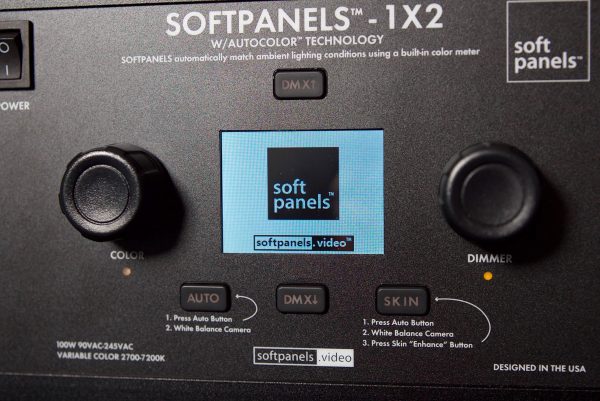
The Skin Tone Enhance feature is claimed to improve skin tones with a push of a button to give a warmer and more cinematic feel. SoftPanels words, not mine. So what is actually happening when you press the Skin Tone Enhance button? Well, it’s the electronic equivalent of putting an 81B filter in front of the light. An 81B filter creates warmer tones and brighter colors on overcast days and is great for improving flesh tones. When you press the button you will see the colour temperature adjust, and just how much it adjusts depends on the original CCT.
Design and build quality
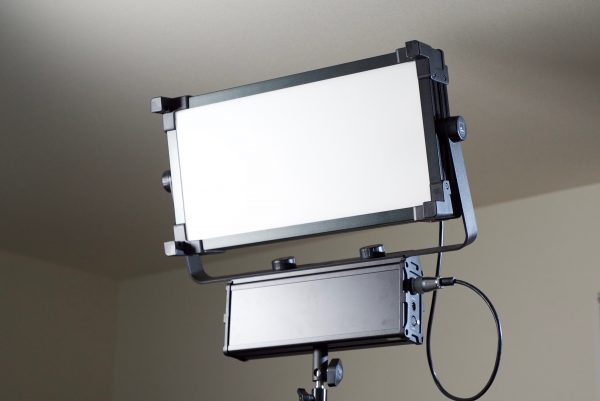
In some ways, the SoftPanels 1×2 is a strange looking light. While most 1×2 sized LED lights like this either incorporate the power supply/control unit in the fixture or have it as a separate removable unit, SoftPanels has done something completely different.
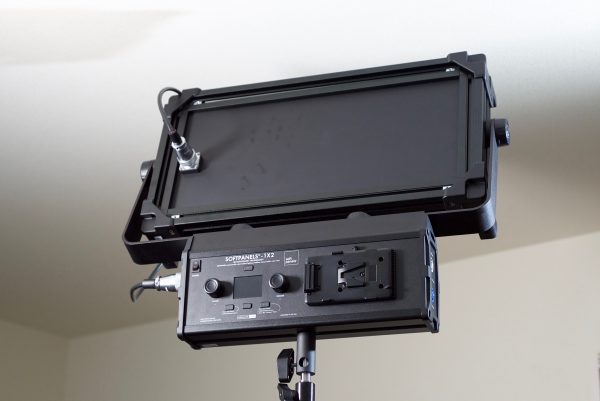
The power supply/control unit is neither here or there. It isn’t incorporated into the fixture, but it’s not really separated either. In somewhat of a strange design decision the power supply/control unit is attached to the yolk frame, which then attaches to the fixture. To be fair to SoftPanels, I can see why they have done this. By positioning the power supply/control unit in this way users can clearly see the controls and they remain horizontal even when you tilt the light fixture itself.
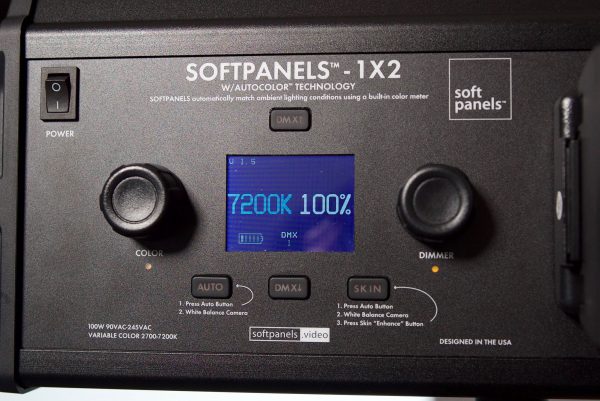
My problem is that you are putting all the weight on top of your light stand. I personally would have preferred to see the power supply/control panel as a separate unit that I could either just place on the floor or hang off the light stand with a loop. Having all the weight in one place makes it a lot harder to use the light out on an arm.
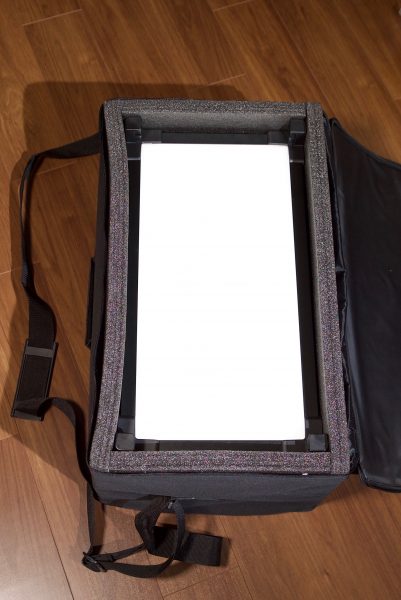
This design of incorporating the power supply/control panel into the yolk also has the adverse effect of making the light a lot bigger. This is a problem when you are transporting the light as it won’t fit in most cases that are available. It certainly doesn’t fit into the included soft case that the light comes in without fully disassembling it.
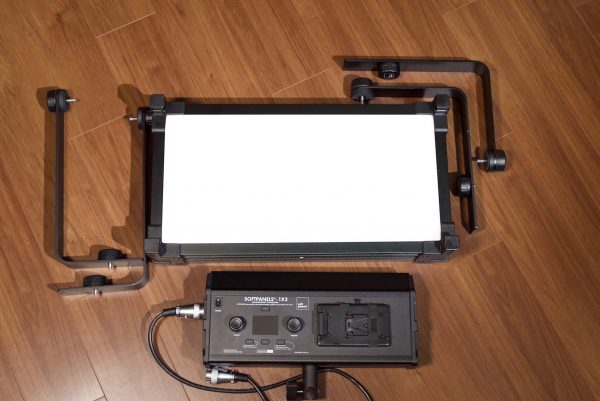
Putting the light together from scratch after pulling it out of this soft bag is nothing short of painful. It’s not an easy process and I found it extremely hard to get the yolk frame attached to the light head. One of the screws just didn’t want to go in and I really had to use a lot of force to finally get it in. Having to build it up from scratch every time you go to use it is far from ideal and you end up wasting time assembling something that you should be able to pull out and use within a few minutes.
SoftPanels do give you two different yolk frame configurations so you can either mount the light horizontally or vertically. This is a nice touch as a quite a few 1×2 panel lights only come with a yolk frame that allows for horizontal mounting. Unfortunately, I couldn’t test the light in the vertical position as one of the yolk frame screws would not go into the mounting point on the fixture.
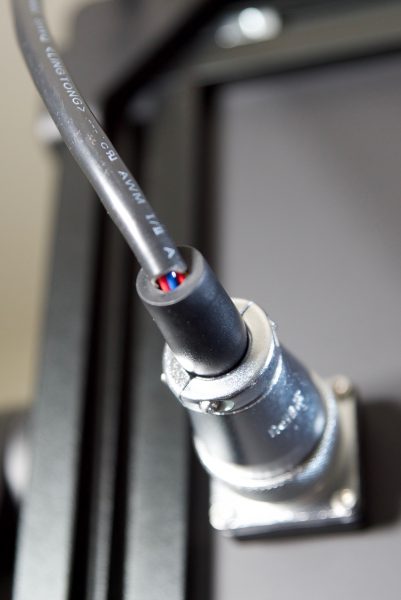
Quality wise I found the construction of the light a little hit and miss. The casing of the light is made out of solid aluminum and feels quite robust, you can certainly feel that in the weight of the fixture. Despite this weight, it does feel a little like an unfinished prototype. That’s not to say that it isn’t solidly made, it’s just that it lacks some of that final polish that I would expect on a $2000 USD light.
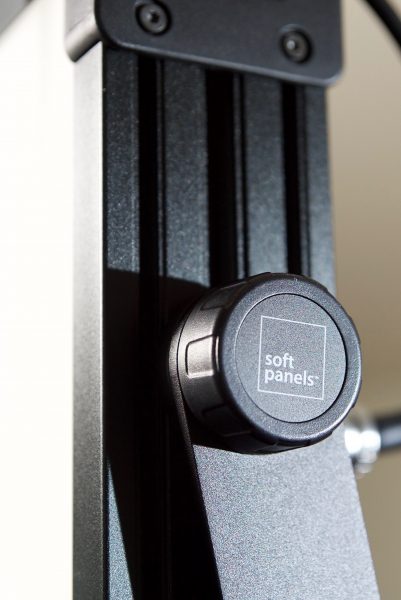
As I mentioned earlier the yolk frame bolts don’t go into the fixture easily, and that tells me a lot about the overall build quality. Attention to detail is what separates good build quality from poor build quality. The yolk frame adjustment knobs are hard to tighten and loosen. They are slippery and you can’t get your hands on them properly. This makes trying to do something as simple as adjusting the angle of the light head more difficult than it should be.
If you are going to use the light outdoors you do need to be aware of the noise it makes if there any type of breeze or wind. The front in-built diffusion panel does move around and you can hear it clearly in windy conditions.
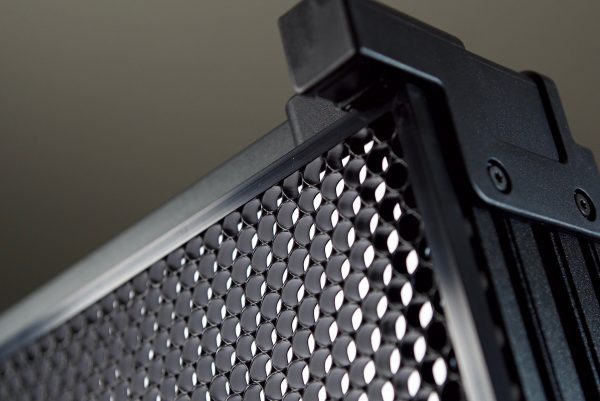
It’s not all bad news though. The power connectors and connections are really solid and well made, and the clip in system for putting in a grid is well thought out and designed. There is also a clip in gel frame that is included with the light, and the included power cable is nice and long.
The power supply/control panel feels fairly solid, but I found the control adjustment knobs to be a little on the cheap side. When you make adjustments to the Kelvin colour temperature or output I also found that the displayed value occasionally jumps all over the place. You can see what I mean in the short video above. When I asked SoftPanels about this I was told that they were aware of the issue and that it was being caused by the real-time meter communication as the lamp CCT output is sending the details back to the power unit and panel.
Size and weight
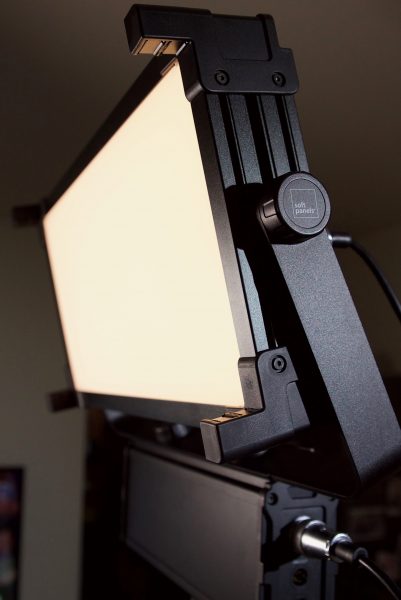
There is no way to sugarcoat it, the SoftPanels 1×2 is a big, heavy fixture. If you are looking for a travel-friendly compact LED light, this isn’t it. When I weighed the 1×2 (with power supply/control panel and yolk frame attached) it tipped the scales at 9kg (19.84lb), which is very similar to the new Litepanels Gemini 2′ x 1′ Bi-Color LED Soft Panel (10.1kg/22.2lb). If you compare that to an ARRI SC60-C SkyPanel (16.5kg/36.37lb with power supply) then it doesn’t sound so bad. But it is heavy when you compare it to other 2×1 panels (with built-in diffusion) such as the F&V Z800S (3.6kg/7.93lb), and Kino Flo Celeb 201 (6.8 kg/15lb including yoke).
Power draw
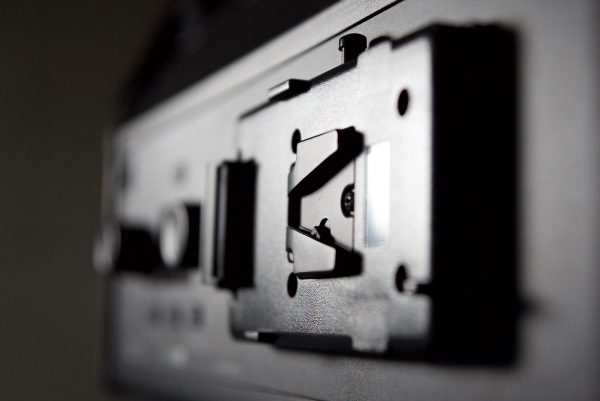
You would expect a large heavy light such as this would be a power hungry beast, but that’s not the case. The 1×2 SoftPanels only draws 100W which allows users to run it off V-Lock or AB Gold-mount batteries depending on which plate option you choose. This low power draw is extremely impressive and it matches the 100W required by the Kino Flo Celeb 201. To give you an indication of just how low it is, the ARRI SC60-C SkyPanel draws 420-450W, the Litepanels Gemini 2×1 Bi-Color LED Soft Panel (325W), and the F&V Z800S (180W).
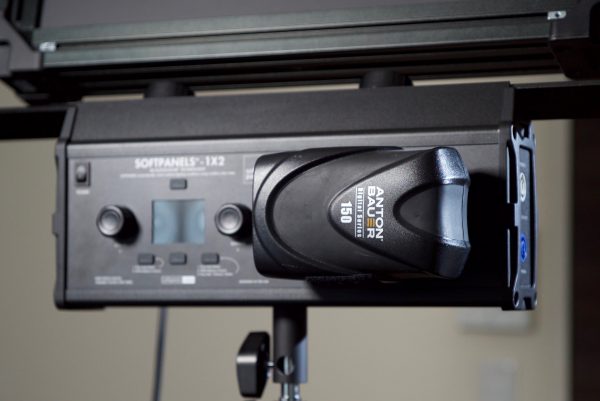
If you are going to power the light from a battery, you need to use a high current model that provides a continuous amperage of > 10A. Anything less will not power the lights.
SoftPanels recommends the following batteries for use on SoftPanels lights from Blueshape:
BV270HD
BV190HD
BV100HD
These batteries have a RED gasket and a RED sticker to designate them as being designed for products with a very high current draw.
IDX
IDX DUO-150
DUO-C190
CUE-D150
E-HL10DS
EHL9
AB Gold mount
Anton Bauer Dionic HCX
The light doesn’t feature any type of fan and it runs silently, however just like a lot of other 2×1 style lights I have tested previously, the back of the fixture does get quite hot after you leave it on for an extended period of time.
Beam Angle
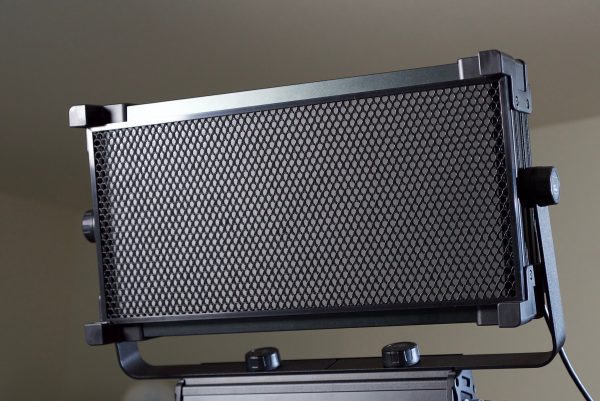
The 1×2 has a very wide 120° degree beam angle which allows you to spread nice soft light over a wide area. This beam angle is very comparable with most other 2×1 sized panels such as the Arri S60 SkyPanel (115º), and the F&V Z800S (130°). The light also comes with a 60° honeycomb grid that helps you direct the light when you don’t want a lot of spill. SoftPanels also gives you the ability to add another (optional) grid which reduces the beam angle to 40 degrees.
Price
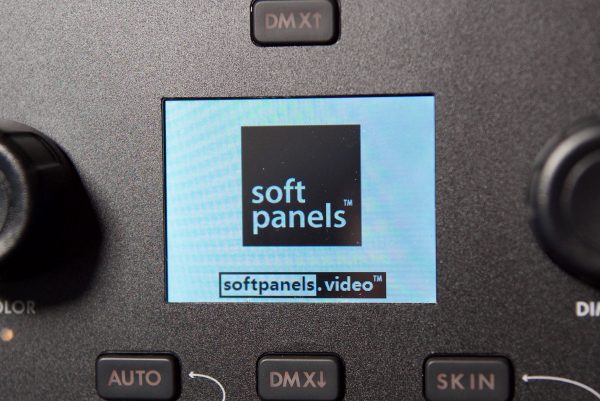
The SoftPanels are very competitively priced for a 1×2 sized panel. The 1×2 retails for $1,995 USD and that price includes a honeycomb grid, gel frame, and soft case. For reference below is what some of the competition costs:
ARRI SC60-C SkyPanel $5,706 USD
Kino Flo Celeb 201 $2,337 USD
F&V Z800S $1,499 USD
Litepanels Gemini $3,999 USD
So now let’s get to the photometric results. I always test lights in this way so that I get a reference to how they compare to other fixtures. Results only tell part of the story and should never be used alone to judge a light. I have found from extensive testing over the years that certain lights that have good photometric results don’t always look good, and lights that have worse photometric scores can sometimes look better than their results indicate.
Output and Kelvin colour temperature accuracy
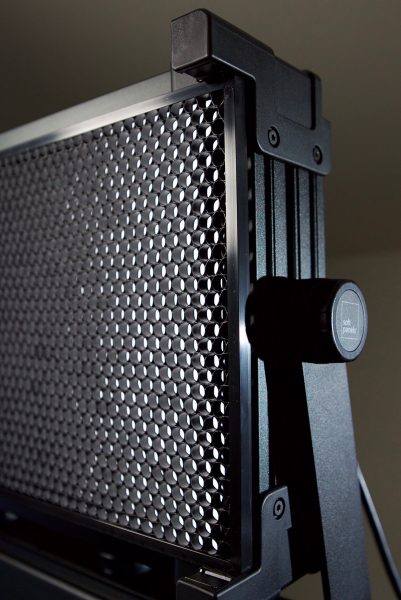
The SoftPanels 1×2 is a large light, but how much output does it have? I tested the light at a variety of Kelvin colour temperatures with a Sekonic C-700 Spectrometer to find out. All readings are taken at a distance of 1m (3.28ft) in a controlled environment.
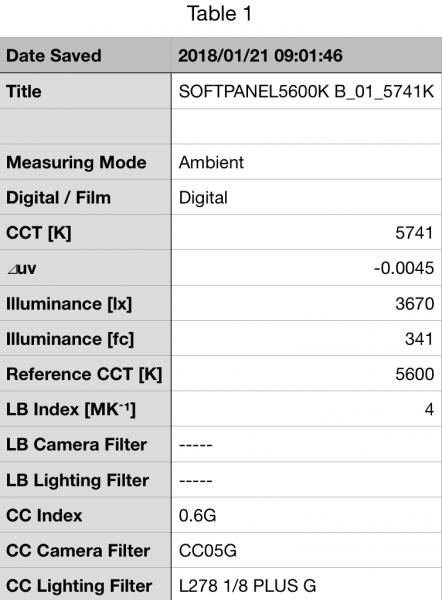
Above you can see the light recorded an output of 3670lx (341fc) when set at 5600K and run off a V-lock camera battery. The 1×2 produced a Kelvin colour temperature of 5741K. 3670lx does not sound like a great amount of output for a light this big, but it’s comparable to other soft panel 2×1 panel lights such as the F&V Z800S, which produces 4040lx (376fc) at 5600K.
While the output is comparable to some other 2×1 sized panels, the SoftPanels weighs considerably more (7.5kg/16.5lb) than a lot of other options that are available. If you were to compare it to other heavy 2×1 panels such as the ARRI S60 SKYPANEL (10900lx at 5600K), it has considerably less output.
As far as Kelvin colour accuracy is concerned the light gave me a reading of 5741K when it was set at 5600K.
I wanted to see if there was any difference in the output if you were running it off mains power and not a camera battery. The light gave me a reading of 3740lx (347fc), which was slightly more than the reading I got when running the light off a battery.
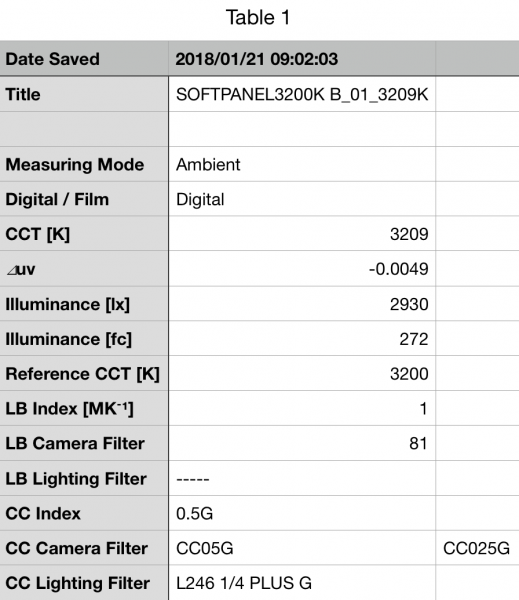
Above you can see the lights output when it was set at 3200K. It produced 2930lx (272fc), which was less than the 3670lx it produced at 5600K. As far as Kelvin colour temperature accuracy goes, it recorded an almost perfect reading of 3209K.
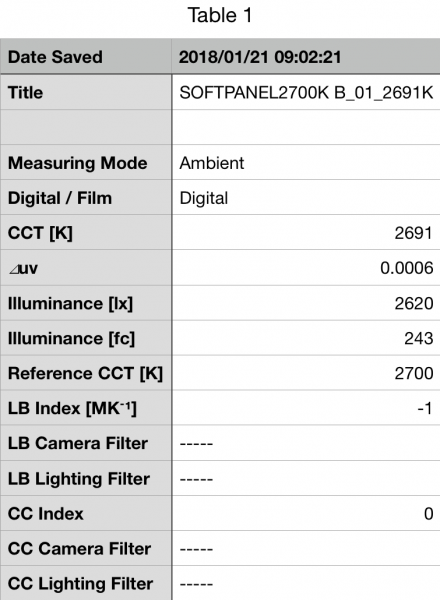
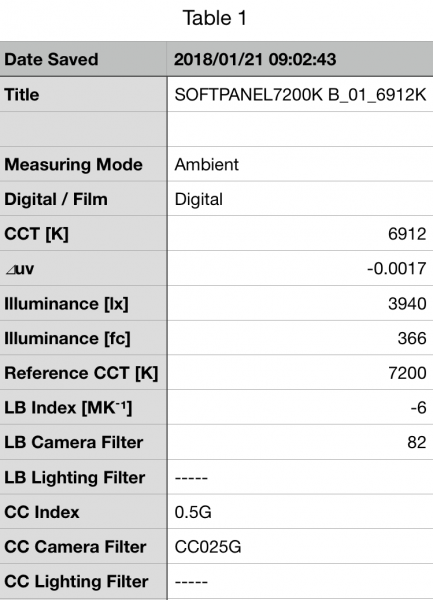
I also decided to test the lights output and Kelvin colour temperature accuracy at both 2700K and 7200K settings. Above you can see that at 2700K the light output 2620lx (243fc) and had a Kelvin colour temperature reading of 2691K. When set at 7200K it produced 3940lx (366fc) and had a Kelvin colour temperature of 6912K.
Summary of results
2700K – 2620lx (243fc) and a Kelvin colour temperature reading of 2691K
3200K – 2930lx (272fc) and a Kelvin colour temperature reading of 3209K
5600K – 3670lx (341fc) and a Kelvin colour temperature reading of 5741K
7200K – 3940lx (366fc) and a Kelvin colour temperature reading of 6912K
These results show me that the light drops output when you start moving the Kelvin temperature dial down. It also shows me that the light is extremely accurate when it comes to kelvin colour temperature reproduction, particularly at 3200K and below. When used at 5600K and above it still does a pretty good job, but it’s still a few 100º Kelvin off.
Color rendering
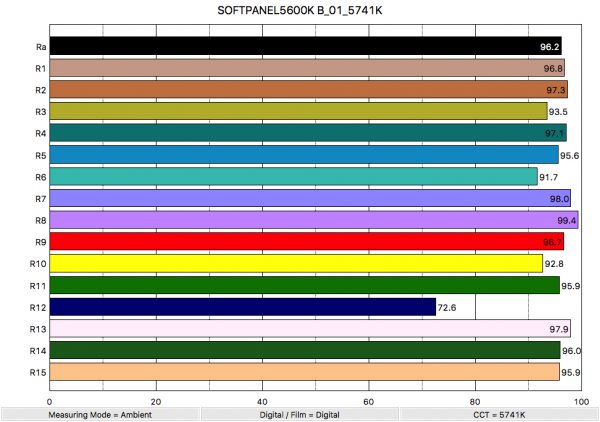
So now that we have seen how much output the SoftPanels 1×2 produces, how does it perform when it comes to replicating accurate colours. Above you can see that when the light was set at 5600K it recorded an average CRI (R1-R8) of 96.2 and an extended CRI (R1-R15) of 94.54. For replicating accurate skin tones it recorded 96.7 for R9 (red), 97.9 for R13 (closest to caucasian skin tones), and 95.9 for R15 (closest to Asian skin tones).
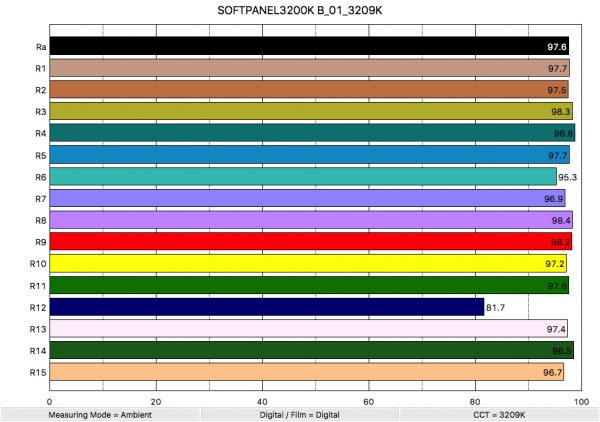
Above you can see the scores for when the light was used at 3200K. It recorded an average CRI (R1-R8) of 97.6 and an extended CRI (R1-R15) of 96.53. For replicating accurate skin tones it recorded 98.2 for R9 (red), 97.4 for R13 (closest to caucasian skin tones), and 96.7 for R15 (closest to Asian skin tones).
SoftPanels quotes a CRI of 95 for their lights, and my testing confirmed these figures to be accurate.
Spectral Distribution
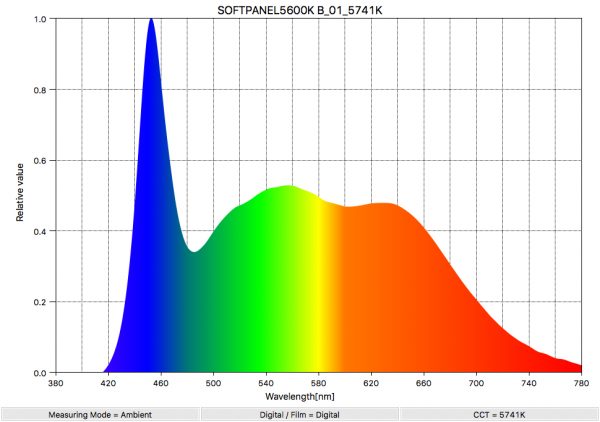
Above you can see the spectral distribution of the SoftPanels 1×2 when it is set at 5600K. The spectral distribution is pretty good at 5600K and you can see there is only a minor green spike.
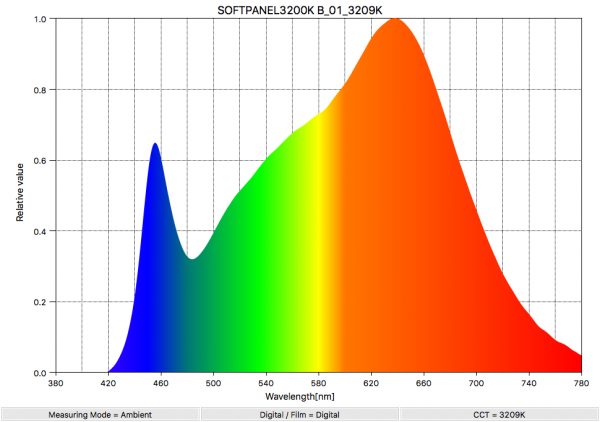
Above you can see the spectral distribution of the SoftPanels 1×2 when it is set at 3200K. The spectral distribution is very good at 3200K for a LED light.
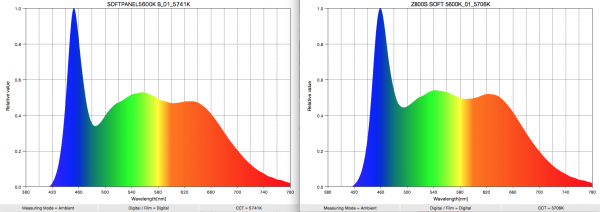
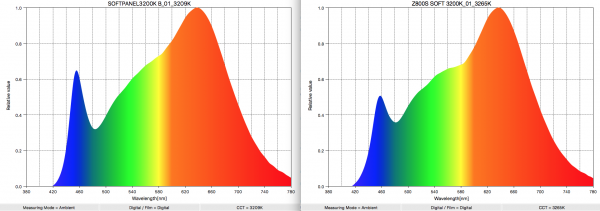
If we compare these results directly against the very good F&V Z800S you can see that the spectral distribution is quite similar at first glance. The F&V definitely has a fuller colour spectrum, but the SoftPanels is pretty close. The SOFTPANES also has one of the best linear spectrums I have seen from a LED light set at 3200K. What you are looking for when viewing spectral distribution is a nice linear line and also no big spikes or troughs in the spectrum.
Real world performance and quality of light
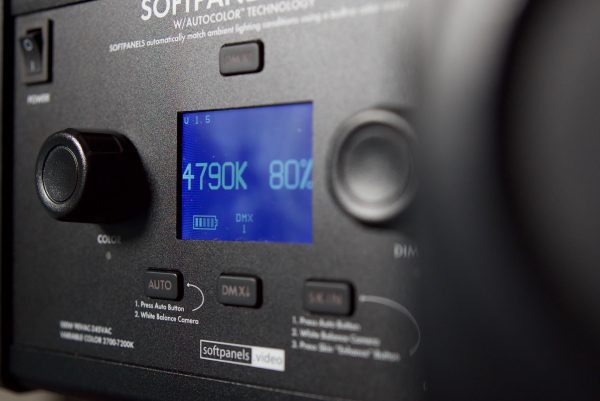
As I always say, photometric scores only tell you part of the story. The proof is always in the pudding. So has SoftPanels come up with a good recipe for producing a nice flattering lighting source? I couldn’t quite put my finger on what it was that I really liked about the quality of the light that was coming from the 1×2. The SoftPanels produces a really nice soft source that is very flattering on skin tones. Whatever the engineers have cooked up when they were designing the fixture, they have got it right.
The wide 120-degree beam angle makes the fixture a nice option for lighting up larger areas, but you do have to be aware of its power output limitations when using it for this purpose. By attaching the included honeycomb grid you can shape the light nicely for interview situations where you don’t want a lot of spill.
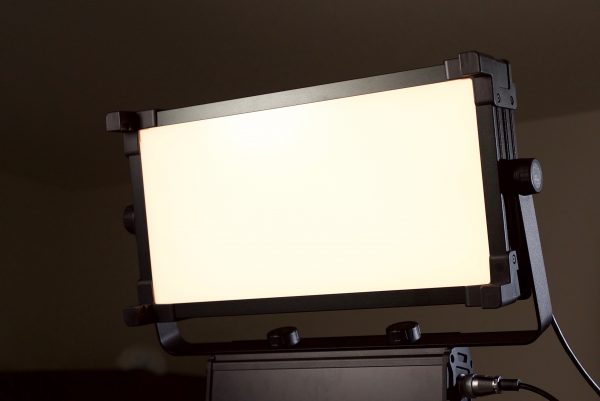
The built-in soft panel allows you to use the light without a softbox, and still create a nice diffused source without sacrificing output. Putting a softbox on a light like this that doesn’t have a massive amount of output is counter-intuitive in my opinion.
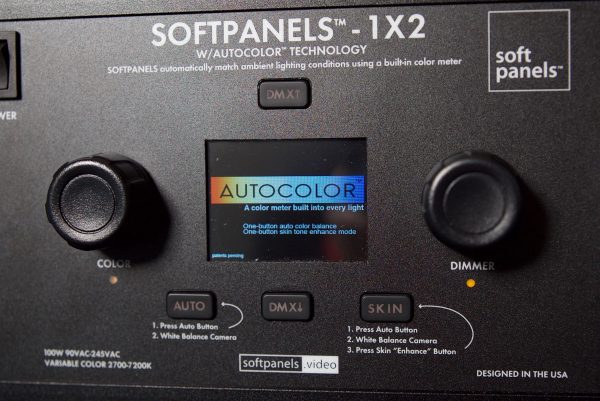
The Autocolor matching technology may sound like a bit of a gimmick, but it actually does work, and better than that, it’s pretty accurate. I was skeptical at first, but after using it on multiple occasions I was impressed by its accuracy in replicating ambient lighting conditions or matching other LED sources. Look, it’s not a miracle worker, and it can’t replicate ambient sources that have green or magenta skews, but it does do a good job when using it in conjunction with other LED lights.
As I mentioned earlier in the article, a lot of LED lights won’t play well with others. Using two or three different brands and then trying to match them can be tricky, to say the least. The SoftPanels gives you the ability to get closer to matching another LED source more accurately. This certainly saves time both on location and when you are in post. The closer you can get all your lights to match when you are shooting, the better.
Conclusion
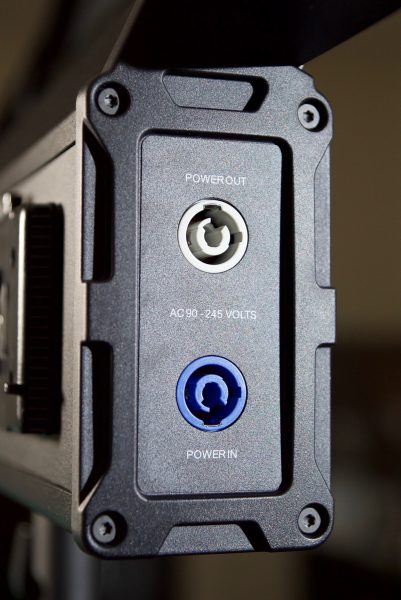
I have a sort of love-hate relationship with the SoftPanels 1×2. On one hand, I love the quality of the light it produces, the low power draw, and the Autocolor matching technology. On the other hand, I don’t like the way they have designed the light, it’s not easy to transport, and the build quality and overall attention to detail make the light feel as though it’s still a prototype.
SoftPanels have got the 1×2 80% right and if you care about the quality of light over anything else then it certainly ticks that box. It’s a good first effort for a new company, but it certainly does need some refinement to take it to the next level. If you are going to ask a consumer to spend close to $2000 USD then there is a certain level of expectation that needs to be met. The SoftPanels chefs have created a good recipe, but they have failed to place it on a plate in an elegant way. As they say, the devil is in the details.
For more information about SoftPanels lights head over to their website.
What do you think about the SoftPanels 1×2, would you buy one? Let us know in the comments section below.



